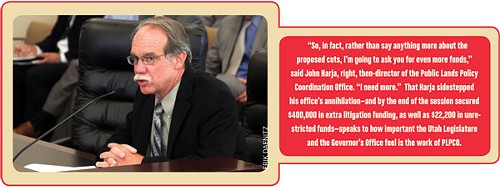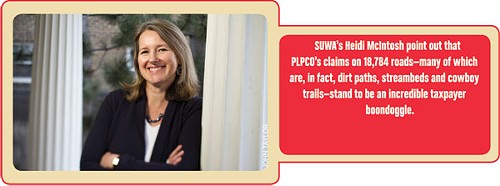The Wild Bunch
Public lands office goes in guns blazing, hiring cronies and sparing no taxpayer expense fighting the feds
By Eric S. Peterson @ericspetersonPage 2 of 3
The issue comes down to a legal standard known as “case or controversy,” which simply follows a no harm/no foul logic. In the case of the roads action, Benson argued that if you can’t prove the feds claimed your road, then you can’t sue to definitively make the road yours.
Benson told the state that even when the federal government designated a wilderness-study area that encompassed land where an old RS2477 road might exist, it would not count as the legal harm necessary to allow the state to sue to get it back. In order for the state to be able to even begin the process, the RS2477 road would likely have to be one the BLM explicitly closed. In the past decade, that would only include a handful of roads throughout Utah. After more than six years in litigation, Benson told attorneys for the state of Utah that this ruling shouldn’t come as a surprise. “I am not telling counsel anything that you don’t already know.”
In the Nov. 17 hearing, Benson partially ruled in favor of the United States, finding that one road could not be claimed by the county and that any claim to a second road was barred by a statute-of-limitations lapse. As for the rest of the roads, Benson needed more time and scheduled another evidentiary hearing on the motion for the end of January 2012.
No Matter the Cost
Harja inherited the PLPCO office in 2008 from predecessor Lynn Stevens, an outspoken San Juan County Commissioner who drew ire from legislators during his short tenure for not keeping track of office financials, which resulted in auditors noting that Stevens had the state expense his weekly car travel between Salt Lake City and his home in Blanding, roughly seven hours to the south. Stevens retired in 2007.
Even with state auditors highlighting Stevens’ travel expenses as a reason why the office needed to get a grip on its finances and keep track of progress, the office was flush with cash—more than they could spend, in fact. The 2009 Legislature allowed the office to keep $260,000 that had been given to the office in 2008. Unspent funds normally go back into the state’s coffers, but the office was able to successfully lobby to keep the money to spend on office equipment and software. Currently the office has $400,000 in reserve funds waiting to be spent on litigation expenses.
Since fiscal year 2010, the office has had roughly a $1.5 million annual budget. The state has also stockpiled $2 million in reserve funds since 2010 for “public lands litigation,” which has sat in a fund untouched. According to an official with the Governor’s Office, that money could be used by other agencies.
Harja’s supervisor, Michael Mower, the state planning coordinator and deputy chief of staff to the governor, says the state’s return on investing in PLPCO has been a major one, and not just in the recent massive RS2477 filing.
“PLPCO staff, including John Harja, have helped the state secure millions in additional tax dollars and mineral-lease payments through their work in helping to facilitate land exchanges,” Mower writes via e-mail. He says the office is also tasked with numerous other important functions involving interactions with the federal government, archaeological permitting and the roads battle. The December 2011 filing on the 18,784 roads “involved field crews, [Geographic Information System] experts, attorneys and other support staff to evaluate the evidence and get the documents prepared and sent.”
Harja decided at the beginning of 2011 that the office needed a new member of its team to aid in this project. In January 2011, he took on Christine Osborne as an indefinite intern.
“Our new special woman”
Osborne was offered a full-time position after only a little more than three months in the office—impressive since she was still juggling her symphony duties during her internship. In May 2011, Osborne was less than warmly welcomed into the PLPCO office as a full-time employee,
according to an e-mail sent from PLPCO Senior Policy Analyst Judy Edwards to Pam Blackham-Bailey, an office administrator with the Governor’s Office.
“Our new special woman employee is making more than Tiffany [Pezzulo], who happens to be a lawyer and has worked here for several years,” Edwards wrote. In a follow-up e-mail that day, Bailey responded, “Whatta mess.”
That Osborne started at $63,000, Harja argued later, was not unusual for his office, since he tries to pay well to attract competent staff. In an interview with City Weekly in November, Harja defended the hire, pointing out that Osborne also had studied public-lands issues in the past.
“She had a [Masters of Public Administration] from the University of Utah—or at least part of an MPA,” Harja said. Osborne did start an MPA program with a Natural Resources Concentration in 1993, but never completed it, according to her resume. (Osborne did not respond to requests for comment for this story.)
In an e-mailed statement, Mower says Osborne’s hiring was one that came after positive recommendations from a few PLPCO colleagues, and was one the governor was not involved in directly. Mower also says that while Osborne didn’t complete her degree in Natural Resources Management, she did carry a 4.0 and had some experience with environmental-impact statements and National Environmental Policy Act documents.
According to Osborne’s résumé, that experience came from her internship with the environmental planning company Bear West in the summer of 1995—16 years before her hire. But Osborne did have experience in public-lands issues prior to 1995, as she also served as a public-lands resource specialist for the Utah Sierra Club. Her environmental activism helped get her quoted in daily papers in the ’90s, criticizing land policies of the first Bush administration.
But the objections to Osborne’s hire from within the PLPCO office went beyond questioning her work experience.
Edwards arranged to have a meeting with Harja on Friday, March 5, 2011, at a time when the office was closed. According to a string of e-mails, Edwards came to meet with Harja, but changed her mind and left as soon as she got there.
When Harja e-mailed Edwards about why she had left so suddenly, Edwards wrote. “It’s Friday. No one else in the office, not your lawyers, advisors, paralegal, analysts or admin assistant, but your handpicked ‘biking buddy’ intern needs to be there???”
The following day, Edwards again challenged Harja in an e-mail about the friendship she perceived he had with the intern.
“I hope you understand yesterday when I said I could read the situation with Christine. Please know that she telegraphs better than a neon billboard. I would encourage you to back out of that (whatever it is and at whatever stage) ASAP,” Edwards wrote, adding “there is just no reason a new part-time intern needs to talk to the director in whispers in the outside hall. No need to defend it to me but I’m sure there are other instances that people are noticing and it just won’t end well. Just a word to the wise. Enough Said!”
That wasn’t the extent of the controversy surrounding Osborne’s role in the office. Her pro-environmental past came back to haunt her when, according to e-mails, an anonymous flier was sent to the Utah Association of Counties. For an association whose members generally share a room with environmental advocates only when that room is a courtroom, the news that Harja had hired Osborne caused the association’s board of directors to meet on Friday, June 24, 2011, and cast a unanimous vote of no confidence in Harja.
Osborne was soon officially let go. But Harja helped land Osborne a position at the Department of Environmental Quality to help the department with environmental-impact statements. On June 30, 2011, DEQ director Amanda Smith agreed to take Osborne on as a research consultant and replied to Harja in an e-mail that reviewing environmental-impact statements “is a role Christine can play—in close coordination with a division staff person.”
But while Osborne physically relocated to the DEQ office, the funds for her salary were still coming from the PLPCO office. And she was also still working for Harja, according to e-mails showing her continuing to work on PLPCO business unrelated to the RS2477 battle.
In September 2011, Harja decided that Osborne was ready for a promotion and e-mailed Smith on Sept. 6, 2011, to propose creating a joint position for Osborne between the two agencies.
“I understand someone is retiring from the section [Osborne] is in. I certainly don’t want to presume anything, but wonder if we could create a shared position for her with that money?” Harja wrote.
Harja, unable to get hold of Smith on the phone, e-mailed her again on Sept. 19 to see what she thought. “I think we could both benefit by having her as a joint employee,” Harja wrote. “Perhaps we could put together a hybrid sort of salary, mixing both agency needs … or?”
While documents City Weekly obtained from the Governor’s Office don’t show a response from Smith, an Oct. 12, 2011, e-mail from Osborne shows her accepting a new joint position between the offices. “I am committed to providing both DEQ and PLPCO with the highest quality work and a strong sense of collaboration, cooperation and service.”
More by Eric S. Peterson
-
The Secret Sauce
How Utah lawmakers disclose—or don't disclose—conflicts of interest.
- Feb 14, 2024
-
Police departments in Salt Lake County spent almost $20 million on civil rights complaints in the past decade
The Co$t of Mi$conduct
- Oct 18, 2023
-
Women decry harassment and toxic culture at St. George auto dealership
Men at Work
- Oct 11, 2023
- More »
Latest in Cover Story
Readers also liked…
-
Forget the family pedigree—Robert F. Kennedy Jr should not be the next president of the United States
Trojan Horse
- Jun 21, 2023
-
Women decry harassment and toxic culture at St. George auto dealership
Men at Work
- Oct 11, 2023






